Midweek Review
Whither the humanities and social sciences in the universities in Sri Lanka? – A short essay

By Prof. Susirith Mendis
Former Vice-Chancellor
University of Ruhuna.
(susmend2610@gmail.com)
I read with much interest, the article by Prof. Farzana Haniffa, Professor and Head, Department of Sociology, University of Colombo, titled ‘Undervaluing Social Science and Humanities teaching in the Sri Lankan University System’ which appeared in ‘The Island’ of 1st February 2022. I understand the predicament she talks about. In that article, Prof. Haniffa alleges that “there is very little recognition or acceptance of the kind of knowledge the H and SS can bring to the table at the level of the UGC mediated Quality Assurance process.” The good professor goes on to describe the diminished role and acceptance of the H and SS in the quality assurance process within our university community. Whereas I agree that there is a need to take immediate cognizance of the need of a large role for H and SS in those processes, I feel that this disregard has deeper and fundamental dimensions.
Hence, I thought it pertinent to submit this article which I wrote for a Prof. Vinnie Vitharana Felicitation volume that was published by the Department of Sinhala, University of Ruhuna. I am submittiing an appropriately re-written version to ‘The Island’ in response.
What I write here is likely to be controversial and may provoke those in the Arts, Humanities and Social Sciences faculties to disagree with some of the thoughts and, perhaps, some suggestions that I make herein.
When one writes on the humanities in the universities, it is imperative that we use some comparative measure. To my mind, without doubt, the ‘Gold Standard’ in this regard is the University of Peradeniya Faculty of Arts (then, the University of Ceylon). Among the great academics who walked tall down the corridors of Peradeniya was the intellectual colossus of that time, Professor Ediriweera Sarachchandra, who gave real meaning to the Sinhala cultural revival of 1956.
Their students kept their ‘flame inviolate’. Professors, Leslie Gunawardene, KM de Silva, KNO Dharmadasa, Ashley Halpe, Merlin Peiris, K. Sivathamby and Ralph Peiris are some names that readily come to mind. They epitomised and represented the highest traditions of academics of post-independent Sri Lanka. Learned and cultured, many had excellent bilingual skills and were exacting in the quality and standards they expected of university academics.
Let me pose some questions. They will remain unanswered in this essay simply because the answers must necessarily lie in extensive and in-depth socio-anthropological research. I am a medical academic with not the slightest pretense to such capability.
Can we truthfully say that the situation improved thereafter? Were the academic qualities and standards maintained thereafter? Were the next generation of academics and scholars able to fit into their shoes once they departed the scene? There are a few exceptions, I agree. But we know that exceptions make the rule. And the rule is that the new generation has not made themselves accomplished as creative intellectuals in the genre and quality of their predecessors. Is there a formula to turnout ‘creative intellectuals’? If so, have we lost the formula?
Was the socio-political upheaval of 1956 itself to blame for this? Did we produce an inward-looking, insular, narrowly nationalistic intellectual class? Especially in the humanities? Or is the present unsatisfactory situation arising out of other causations?
Would some academics argue that the ‘nativisation’ of the intellectual and the academic, post’56, is in itself a positive outcome; that the pre-’56 intellectuals were the remnants of the British ruling class – the “Pukka Sahibs”; whereas the ‘children of 56’ are the true inheritors of the earth, born of earth, sons (and daughters) of the soil, nurtured by the cultural founts and milieu of indigenous Sri Lankan traditions?
One is reminded of the famous statement of the Black-Algerian political theorist, psychoanalyst and revolutionary-philosopher, Frantz Fanon (1925-1961) in his celebrated book “The Wretched of the Earth”. Referring to the elites of post-World War II, post-independent, post-colonial nations, he wrote that they use “glutinous words that stick to their teeth”. The sub-title of the book is more descriptive and intended – “A Negro Psychoanalyst’s Study of the Problems of Racism and Colonialism in the World Today”. Fanon argued that language has a role in moulding the attitudes of “natives”, particularly those victimised by colonisation. He believed that the language that the colonials taught us made us really incoherent when describing our socio-cultural and political predicaments. Almost saying that we spoke in a language, the real meaning of which we ourselves did not clearly understand. Or we were merely mouthing words of our colonial masters. So were our last generation of pre-independent, pre-’56 intellectuals, elites as Fanon describes them? Or are we now living in an era where the thoughts and words of Fanon and like-minded intellectuals have become irrelevant?
It might be opportune at this point in my essay to cite two Sri Lankans (intellectuals in their own right) that may give some insight to the current dilemma and predicament of the Humanities and Social Sciences. These are anecdotal, but since they were said in my presence, though not directly to me, I vouch for their veracity.
The first is during the time I spent (1980-83) as Lecturer in Physiology at the Faculty of Medicine, Peradeniya. I was more at the Medical Education Unit (MEU) there, than the Department of Physiology, as it was a WHO Regional Training Centre in Medical Education and had many medical academics from South Asian countries visiting regularly. One regular visitor to the MEU was Prof. Thiru Kandiah (then Senior lecturer). Talking about the lack of originality of thought and hence academic creativity, Prof. Thiru Kandiah said (a quote from memory) “… Until our intellectuals begin thinking in their own native language (Sinhala and Tamil), we will not generate original thoughts that are essential for genuinely creative knowledge.” When I reminded him of this statement when I met him after a lapse of nearly 30 years, he could not quite remember that he said it. Neither did he say that he agrees with that thought. Perhaps, he had changed his mind about such a concept in the intervening years. I did not ask him whether he had. But taking it in the context of what Fanon wrote in 1961, this is a concept that needs to be debated by academic psychologists, linguists, anthropologists and other social scientists. But, if this theory is correct, since we now have academics who are mostly monolingual in academic accomplishments and training, and therefore they are likely to be ‘thinking’ in their own language, there has to be a gush of academic writings and publications that are truly creative. Is there?
The second is a chance conversation that I was party to during a tea break at a conference in Colombo. Prof. Chris Weeramantry was the keynote speaker. Again, on the subject of intellectual creativity, he observed that in the Sciences, which are based on the Western, Judeo-Christian, and Graeco-Roman traditions that we know today as the Western Philosophical Tradition, we will hardly, if ever, be creative. We will continue to mimic the West most often and if ever we become creative in the sciences, at best, they will be extremely marginal. He further said that we have real contributions to make to the world of knowledge in the humanities and law. Humanities, because our indigenous cultures and value systems are based on the Eastern Philosophical Tradition and in Law we have a very long legal tradition based on Buddhist Ethics. Do you agree?
Therefore, we should have had a great flowering of creative intellectual activity emanating from the humanities and social sciences and the law. Unfortunately, with a few exceptions, we have not seen such creativity. Large numbers of academics in the humanities and social sciences, due to their limited language competencies have a limited world view. Generation of new knowledge requires an open and expansive mind set that can be acquired only through widening one’s experience directly or through extensive reading – particularly, readings from other experiences and cultures. I have observed that there is a resurgence in the translations of classics from English, Russian, German and French literature into Sinhala.
There are, but less so, even from the Japanese, Chinese and Korean. Are these truly quality works of translation? What is the readership? Have these had any impact on the ‘intellectual creativity of monolingual academics? If not, why?
Has the neo-liberal economics that pervade the globe affected the creativity in the humanities and the arts? Is globalization somehow responsible? Have our ‘thinkers’ who have no financial/economic value in the marketplace been replaced by commercial interests? Why have academics and intellectuals succumbed to the marketplace without much resistance? Not physical, but intellectual? Why is there no debate, as one would have expected, on whether education is a public good or a marketable commodity? Is it because our intellectual critical mass has so declined that the remaining cannot make the difference? Is this not due to the decline in the quality and standard of our academia in the Humanities and Social Sciences?
In my view, there is an intellectual/academic crisis in the areas of the humanities and social sciences in all universities in Sri Lanka at present. Though it is, perhaps, least in the University of Peradeniya, the situation has gone beyond the limits of complacency. I use a medical analogy to describe a university. The sciences – medicine, engineering, agriculture, applied and pure Sciences – form the bones, sinew and muscles and blood that runs in the veins of a university. The humanities and the arts must provide the ‘spirit’, the ‘soul’ of a university. This was how the Peradeniya Faculty of Arts played its true role in its best years. That is why it was a fount of creativity in its early years and the pride of our university system.
The Harvard Magazine in its 1998 issue (nearly 25 years ago), has an article titled ‘The Humanities at Harvard: A Profile’. The article commences with the following which I quote:
“For nearly two centuries, learning at Harvard largely meant learning in the humanities. Other fields were taught–mathematics, for instance, and, increasingly in the nineteenth century, natural science and the emerging social sciences. With foresight, Harvard often led the change away from higher education centered almost exclusively in humanistic pursuits. But the humanistic tradition remains vital.”
Later, it goes on to say:
“Although Harvard undergraduates in the humanities are heard to worry about the relevance and ‘utility’ of their studies for the purpose of later employment, no statistical evidence indicates that Harvard-minted humanists have a tougher time later in the job markets, or that they become any less successful than their peers.”
Though the registration of students for the humanities has fallen, and the demand is less compared with other professional study programmes, the fact that Harvard considers the humanistic tradition as vital, is noteworthy.
The online Harvard Business Review (31 March 2011) has this article titled ‘Want innovative thinking? Hire from the Humanities’ which is necessary reading for those in want of a justification for the persistence of humanities education in the universities. I will quote from it at length:
“How many people in your organization are innovative thinkers who can help with your thorniest strategy problems? How many have a keen understanding of customer needs? … There are plenty of MBAs and even PhDs in economics, chemistry, or computer science, in the corporate ranks. Intellectual wattage is not lacking. It’s the right intellectual wattage that’s hard to find… This is because our educational systems focus on teaching science and business students to control, predict, verify, guarantee, and test data. It doesn’t teach how to navigate “what if” questions or unknown futures…The knowledge I use as CEO can be acquired in two weeks…he main thing a student needs to be taught is how to study and analyse things (including) history and philosophy. People trained in the humanities who study Shakespeare’s poetry, or Cezanne’s paintings, (for instance) have learned to play with big concepts, and to apply new ways of thinking to difficult problems that can’t be analyzed in conventional ways.”
The author goes on to say that the ‘liberal arts crowd’ can help when (i) there is ambiguity and complexity in business problems – both opportunities and threats – that the usual logical thinking cannot solve; (ii) where what is needed in innovation and ‘out of the box’ thinking; and (iii) when looking at the ‘big picture’. The author further says that a case in point is “….., who openly acknowledged how studying the beautiful art of calligraphy led him to design the Macintosh interface.”
Can Professor Haniffa tell us whether she and her department prepare students to be graduates who can fill in roles that the CEO above talks about? Forgive me, if I think that it is mostly unlikely except for may be – a significant few.
Unlike in Sri Lanka, the study of the humanities has been included into the sciences, including medicine. The Yale School of Medicine, for instance, has a Medical Humanities and the Arts Council based at the medical school. Based at the School of Medicine, the Council is an advocate for the medical humanities and the arts, encouraging and coordinating rigorous scholarship in these areas, including medical student research.
We did make attempts to do so at the Faculty of Medicine at Ruhuna, but it has gone into abeyance and a natural death, I think, due to a lack of interest. But, fortunately, the Colombo Medical School has recently established a Department of Medical Humanities and is doing, in my view, critically important pioneering work towards producing better, thinking, and more humanistic doctors.
The University of Cambridge, School of the Humanities and Social Sciences in its website proudly announced a few years ago that “outstanding graduates from across the world want to study the Humanities and Social Sciences at Cambridge, and the School wants to take them.” The Vice-Chancellor of the University of Cambridge, Professor Sir Leszek Borysiewicz had announced the creation of a £300,000 fund to be awarded to Cambridge University researchers in the arts, humanities and social sciences.
In Sri Lanka, the Ministry of Higher Education had committed about a decade ago, Rs. 100 million each year for the next five years to take six universities to international status. Together with the offers of financial support to the humanities and social sciences faculty academics to pursue doctoral studies, this is a golden opportunity for the academics in the humanities and social sciences to grasp with both hands. I wonder whether the scheme is still on.
Unfortunately, in Sri Lanka, there is negative thinking at the present time that the learning of the humanities is a waste of time. Its graduates have no future in obtaining gainful employment and therefore the humanities must be replaced with ‘marketable’ degree programmes. Modules and courses in computer science and IT is beginning to be included in the humanities curricular to make ‘arts graduates’ more marketable. Why have we reached this viewpoint? I believe that the academics in the humanities must accept a large part of the blame. The faculties of Humanities and Social Sciences and the Arts in our universities have not equipped themselves to meet the challenges of the present and the future. This must change, and change for the better, radically and very soon.
We need a more vibrant academic faculty in the humanities and social sciences; (i) a faculty that is grappling with the current social-political issues; (ii) academics that can develop new analytical tools and frames to dissect not only socio-cultural and political issues, but existential, ethical and philosophical issues as well; (iii) development of quality research programmes to search for answers to the Sri Lankan experiences in a post-conflict situation; (iv) look for explanations for the socio-cultural bases of violence in our society; (v) create a academic framework for a more responsible and intellectually responsive media culture; and (vi) build interdisciplinary degree programmes and research projects with the science and legal disciplines. These are some of the current imperatives that must be thought through among academics in the humanities and social sciences.
In this essay, I, who come from the sciences, have made a case for the resurgence of the Humanities and Social Sciences in our universities. It is up to the academics in these faculties to take up the challenges with rigorous scholarship and commitment and conviction. It is time, and never too late, for a definitive revival and rejuvenation of the best traditions of teaching, learning and intellectual creativity of the Humanities and Social Sciences in the universities in Sri Lanka. But I do not see that happening. Both at national policy level nor at the level of academics in the humanities and social sciences.
Midweek Review
North: A change in status ahead of Maaveerar Naal
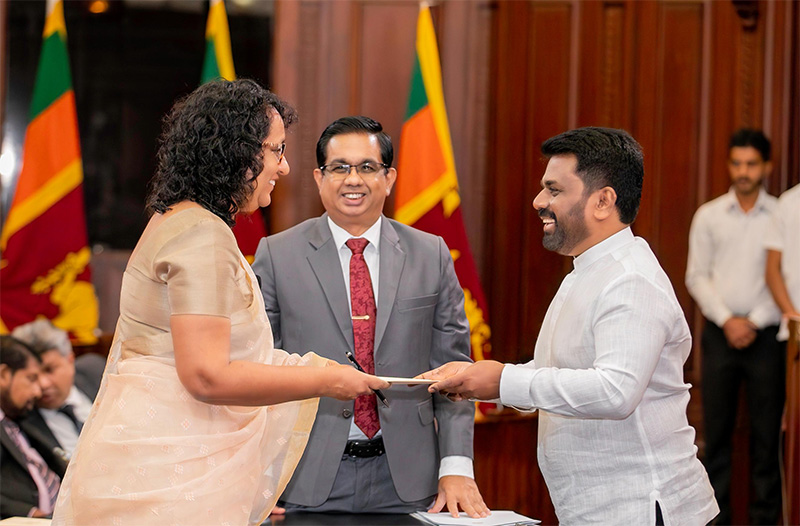
* One-time LTTE mouthpiece TNA is no more
* N & E Tamil speaking representation enhanced
* Fresh look at Sarath Fonseka’s performance at 2010 Prez poll in North required
The new government’s main challenge is ensuring the full implementation of the IMF-led post-Aragalaya economic recovery in line with the Economic Transformation Bill approved by the previous government without a vote. Whatever the side-shows, the focus not only of the government but the Parliament should be on preparing the country to resume debt repayment in 2028 or be ready to face the consequences.
By Shamindra Ferdinando
In a way it was a great thing for the country that the National People’s Power (NPP) scored an emphatic victory at the Nov. 14 general election. Now the Janatha Vimukthi Peramuna (JVP)-led NPPers can have no excuses for not being able to fulfill their promises as would have been the case if the preceding September Presidential election outcome was repeated with the combined Opposition having the lion’s share of the vote, which would have left the country with a virtual hung Parliament of no benefit to anyone other than creating a parliamentary stalemate, leading to fresh political chaos.
We will, however, grant the fact they have a very tall order to fulfill after the previous governments having virtually signed away our sovereignty with the deals they had inked during their tenures.
But we do have a nagging suspicion about someone working in not so mysterious ways against us behind the scene, after what the former US Secretary of State, John Kerry, publicly stated not too long after the defeat of President Mahinda Rajapaksa at the 2015 presidential election when he crowed to the whole world how they had spent several hundred million dollars for regime change operations at the time in several countries, including Sri Lanka. Then we also know since then how a US engineered coup ousted the popularly elected Prime Minister of Pakistan Imran Khan by way of parliamentary and military shenanigans, and then the more publicised way they ousted Prime Minister Sheikh Hasina of Bangladesh and then virtually ruined that country as was the case during the Aragalaya here in 2022 to oust the legally elected President, with a wide mandate, Gotabaya Rajapaksa.
The NPP has accomplished the impossible, even in the North, in the form of securing the Jaffna electoral district at the recently concluded parliamentary election. The NPP obtained three seats, nothing but a historic watershed.
The ruling party also won the Vanni electoral district, the scene of some of the bloodiest fighting during the Eelam War IV (Aug 2006-May 2009). Securing Jaffna and Vanni consisting of Vavuniya, Kilinochchi and Mullaitivu administrative districts, is as difficult as eradicating the conventional fighting capability of the Liberation Tigers of Tamil Eelam (LTTE). The NPP won two seats in the Vanni.
The final phase of the ground offensive was conducted in a corner of the Vanni electorate where LTTE leader Velupillai Prabhakaran met his maker.
The NPP secured two seats in Trincomalee and one in the Batticaloa districts, whereas Digamadulla gave President Anura Kumara Dissanayake’s party four more seats. Altogether 12 out of 29 parliamentary seats available in the five above-mentioned electoral districts ended up with the NPP.
The NPP delivered the stunning blow to those who still pursued separatist agenda, regardless of the LTTE’s demise over 15 years ago. The combined armed forces brought the war to a successful conclusion in May 2009.
The Illankai Tamil Arasu Kadchi (ITAK)-led Tamil National Alliance (TNA) that dominated the Northern and Eastern provinces since 2001 hadn’t been in the fray at the 2024 general election. The TNA that had been in the grip of the LTTE, during 2004-2009, disintegrated 15 years after the end of war, with the ITAK unceremoniously ending the partnership. Ex-TNA members, EPRLF, TELO and PLOTE contested the general election under the ticket of Democratic Tamil National Alliance (DTNA).
The ITAK obtained seven seats (Batticaloa three, Jaffna one, Vanni one, Digamadulla one, Trincomalee one) whereas DTNA won just one (Vanni one). It would be pertinent to mention that ITAK and DTNA fielded a common list for the Trincomalee district to ensure a split in the Tamil vote wouldn’t cost the community much valued representation therein. ITAK Trincomalee leader Kathiravelu Shanmugam Kugathasan, who replaced R. Sampanthan in Parliament at the last Parliament, won that seat.
In addition to the seven elected, the ITAK that contested under the ‘House’ symbol won one National List slot. Ahila Ilankai Tamil Congress (AITC) was the only other party to secure a seat (Jaffna/ Gajendrakumar Ponnambalam) while Independent Group 17 (Jaffna/ Ramanathan Archuna) won one. Altogether Tamil political parties obtained 11 seats, one less than the NPP.
M.A. Sumanthiran (ITAK/Jaffna), Dharmalingham Siddharthan (DTNA/Jaffna) and Sashikala Nadarajah (DTNA/Jaffna), widow of slain ITAK MP Nadarajah Raviraj were some of the big losers. In the east, one-time Chief Minister of the Eastern Province Sivanesathurai Chandrakanthan alias Pilleyan, formerly of the LTTE, failed to retain his Batticaloa district seat. Former LTTE field commander and ex-lawmaker Vinayagamoorthy Muralitharan aka Karuna Amman made an unsuccessful bid to re-enter Parliament also from the Batticaloa district.
In the previous Parliament, there had been 16 MPs representing five Tamil political parties (ITAK, AITC Eelam People’s Democratic Party [EPDP], Tamil Makkal Viduthalai Pulikal [TMVP] and Tamil Makkal Thesiya Kuttani [TMTK]. Last week’s poll eliminated EPDP, TMVP and TMTK while new entrant NPP created political history by winning 11 seats.
In spite of the humiliating setback suffered by those who had been previously in Parliament, the NPP tally has increased the total strength of the Tamil-speaking group representing N & E in Parliament. Perhaps, the successful formation of NPP’s Tamil-speaking wing may influence other political parties to re-examine their overall political strategy. They may not have any other alternative as failure to do so can further weaken their position at the forthcoming Provincial Council and Local Government polls. PC and LG polls are expected to be held next year.
Shanakiyan Rasamanickam, who re-entered Parliament with a convincing win in Batticaloa, consolidated his position, within the party and the district, due to ITAK’s admirable performance there. If not for three Batticaloa seats, ITAK aka Federal Party would have been in an utterly embarrassing position. Batticaloa electoral district is the only one that the NPP couldn’t win. Therefore, the outspoken Rasamanickam can be really happy to have thwarted the NPP in the eastern district.
Now to bury the hatchet between the two or, more correctly, the three literally warring communities here, NPP will have to think out of the box to find a solution that may be by way of sharing power at the centre rather than the periphery, as was successfully done under the Donoughmore Constitution.
Accountability issues
At the presidential election held in Sept. the NPP couldn’t win at least one electorate in the North but did so well several weeks later, it could win Jaffna and Vanni electorates. If not for that sterling performance, the NPP couldn’t have secured an unprecedented 2/3 majority. President AKD should be ever grateful to the northern and eastern electorates for facilitating a 2/3 majority.
Since the introduction of the proportional representation at the 1989 Parliamentary election, no party succeeded in securing a 2/3 though many alleged the Rajapaksas abused such huge mandates. They were, of course, referring to the UPFA securing 144 seats and 145 seats at the 2010 and 2020 general elections, respectively. For a simple majority, the winning party needs 113 seats while 2/3 means 150 seats.
Against the backdrop of NPP’s victory in the N & E, the new Parliament should review Sri Lanka’s response to post-war accountability issues. Since the eradication of the LTTE, the TNA propagated politically motivated unsubstantiated war crimes allegations, both here and abroad. Finally, the treacherous Yahapalana government (2015-2019) betrayed the war-winning armed forces at the Geneva-based United Nations Human Rights Council (UNHRC) in Oct 2015. The accountability resolution that had been co-sponsored by the US-led grouping and Sri Lanka was meant to pave the way for a new Constitution aimed at doing away with the country’s unitary status.
Interestingly, the war-winning Army Commander, Sarath Fonseka, who had been promoted to the rank of Field Marshal, in March 2015, served in that Yahapalana Cabinet, chaired by President Maithripala Sirisena. The role played by the then Premier Ranil Wickremesinghe and the late Foreign Minister Mangala Samaraweera in that despicable act is in the public domain. The failure on the part of Fonseka, who served President Sirisena’s Cabinet to vigorously oppose the government move is still a mystery.
The writer repeatedly discussed the failure on the part of Parliament and urged concerned political parties to raise the Yahapalana-TNA Geneva operation after the same lot fielded Fonseka as the common presidential candidate in 2010. Although Fonseka lost the contest by a massive 1.8 mn votes to war-winning President Mahinda Rajapaksa, he handsomely won the Jaffna, Vanni, Trincomalee, Batticaloa and Digamadulla electoral districts at the same election.
The NPP’s excellent showing in the N & E at the recently concluded general election should be examined taking Fonseka winning the former war zones 14 years ago.
Having alleged Fonseka’s Army of war crimes throughout the northern campaign, the TNA had no qualms in backing the Sinha Regiment veteran. Unfortunately, political parties represented in Parliament never bothered to raise TNA’s duplicity. Instead, all of them shamelessly and brazenly played politics with the issue, seeking petty political advantage at the expense of the armed forces. There hadn’t been a single instance of a war-winning country betraying its armed forces hitherto anywhere in the world. It was only the Maithripala Sirisena/Ranil Wickremesinghe govt. that achieved that dastardly act.
The JVP, though being not part of the Yahapalana Cabinet, never opposed the government’s move against the armed forces. However, the NPP’s victory in the North, perhaps would give an opportunity for President AKD, who is also the Defence Minister and Commander-in-Chief of the armed forces, to address the issue at hand afresh. President AKD retained the Defence portfolio when the new Cabinet of Ministers was sworn in last Monday.
The developing situation in the North may help post-war national reconciliation efforts. Successive governments deliberately allowed further deterioration of relations between the two communities by not taking apt remedial measures. Those who propagated lies were allowed to do so much to the disappointment of the armed forces. Parliament turned a blind eye even when the US and Australia et al denied visas to retired and serving officers and US imposed travel ban on the then Army Commander Gen. Shavendra Silva, the incumbent Chief of Defence Staff (CDS). Maj. General Chagie Gallage, now retired, is another victim of external reprisals.
Maaveerar Naal (Great Heroes’ day)
The Tamil Diaspora must have been quite surprised by the outcome of the general election. Some interested parties played down the importance of NPP victory in the North on the basis of low turnout of voters. It would be interesting to observe how the Diaspora and political parties here mark this year’s Maaveerar Naal. Commencing 1991, the LTTE used to celebrate Nov. 21-27 week as Great Heroes Week. During the period the group wielded power, the weeklong celebrations and activities received even international media attention.
This year, Maaveerar week is scheduled to commence on Nov 21 (tomorrow), the day the 10th Parliament meets. What would those elected from the NPP, ITAK and other parties do this year? Would interested parties seek to cause some unnecessary commotion in a bid to embarrass the government. Let us hope the government would handle the situation cautiously as opportunistic elements on both sides seek to exploit the developments. ITAK’s Sivagnanam Shritharan paid tribute to fallen Maaveerar at Kanagapuram, Kilinochchi.
The NPP’s unexpected victory in the north may compel not only Tamil Diaspora but Western countries, particularly Canada, to review their position.
Canada declared May 18 as Tamil Genocide Remembrance Day as Premier Justin Trudeau’s government sought to appease Canadian voters of Sri Lankan origin. Canada cannot under any circumstances ignore the Tamil vote received by the NPP as people discarded unsubstantiated war crimes allegations directed at the government, for the second time. Had the northern electorate believed the Army wantonly killed civilians on the Vanni east front in 2009, as alleged by the UN, they wouldn’t have voted for Fonseka. Perhaps, the people wanted the government to bring the war to an end at any cost. Having waged two terror campaigns in 1971 and 1987-1990, the JVP should be able to comprehend the need and the responsibility on the part of the government of the day to take whatever measures necessary to deal with the challenge.
The NPP was formed in 2019 just months ahead of the presidential election as the JVP realized it couldn’t push ahead on its own but needed wider public support. The NPP achieved that with ease within six years.
In August 2006, the then President Mahinda Rajapaksa went ahead with an-all-out campaign against the LTTE after failing to convince them to negotiate for a final settlement. President Rajapaksa had no option but to go on the offensive after the failed LTTE assassination attempts on the then Army Commander Lt. Gen. Fonseka (April 2006) and then Defence Secretary Gotabaya Rajapaksa (Oct. 2006). The TNA remained committed to the LTTE’s murderous cause until the very end.
A matter for serious concern
An unbelievably large number of voters skipped the general election. All political parties, including the NPP, should be concerned over the unprecedented deterioration of voter interest, especially after a thrilling presidential election brought AKD to power just six weeks ago. A substantial increase for the NPP from 5,634,915 votes (42.31 %) at the presidential to 6,863,186 (61.56%) at the general election just weeks later shouldn’t be allowed to divert attention to the massive drop in public interest. Well over half a million rejected votes, too, must worry all.
The NPP won 159 seats, including 18 National List slots, nine more than required for a 2/3 majority. At the presidential election 3,520,438 voters refrained from exercising their franchise. But that figure increased to 5,325,108 at the general election while the number of rejected votes, too, recorded a significant increase. According to the Election Commission, at the presidential poll, the number of rejected votes was 300,300 while the general election recorded 667,240 rejected votes.
What really caused such an increase in the number of rejected votes was when the number of polled votes dropped from 13,619,916 votes (79.46%) to 11,815,246 (68.93%)? In other words of the 17,140,354 people eligible to vote, a staggering percentage decided not to. Voter apathy is not healthy. Not healthy at all.
A rethinking on the part of the SJB and New Democratic Front (NDF/consisted of former SLPP lawmakers and UNP) is necessary as they couldn’t at least retain the number of votes received at the presidential election. SJB that polled 4,363,035 votes (32.76 %) at the presidential poll could muster only 1,968,716 (17.66%) at the general election, while NDF could secure 500,835 (4.49%) having polled 2,299,767 (17.27%) just weeks ago. The SJB and NDF ended up with 40 seats (including five NL slots) and five seats (including 2two NL slots) while the SLPP that won 145 seats at the 2020 general election had to be satisfied with three seats, including one NL slot.
Both Sajith Premadasa and Ranil Wickremesinghe should seek remedial measures before the EC announced PC and LG polls. Perhaps, divided groups have to unite under one banner either under SJB or UNP or face annihilation at the PC and LG polls. For Premadasa and Wickremesinghe time seemed to have run out.
The SLPP obtained 350,429 votes (3.14%) at the general election up from 342,781 (2.57 %) at the presidential election. For the SLPP a rapid recovery process will never be possible as its only NL member and leader of the minute group Namal Rajapaksa is likely to be the target of corruption investigations. The SLPP group consists of Namal Rajapaksa, newcomer Chanaka Sampath (Galle) and D.V. Chanaka (Hambantota).
Fifteen political parties represented the last Parliament. They were SLPP (145), SJB (54), ITAK (10), NPP (03), EPDP (02), AITC (02), TMVP (01), SLFP (01), MNA (01), TMTK (01) TMTK, ACMC (01), NC (01), SLMC (01), UNP (01) and OPPP (01). The new Parliament will be represented by 13 political parties and one independent group – namely NPP 159, SJB 40, ITAK 08, NDF 05, SLPP 03, SLMC 03, Sarvajana Balaya (NL), UNP (01), DTNA (01), ACTC (01), ACMC (01), Jaffna Ind. Group 157 (01) and SLLP (01).
Midweek Review
‘Ramayanizing’ Sri Lanka by Courtesy of SriLankan Airlines

 (The author is on X as @sasmester)
(The author is on X as @sasmester)
SriLankan Airlines’ five-minute commercial promoting the so-called ‘Ramayana Trail’ in Sri Lanka is being accepted very naively as an enticing and heartwarming advertisement by Sri Lankan and Indian viewers across social media. Predictably, the video has also gone viral. It shows a young child being educated about aspects of the Ramayana legend by his grandmother, while zooming in on locations in Sri Lanka where local mythology has made associations with some narratives of the Ramayana. Beyond the rave reviews of the commercial in Sri Lanka and India, an astute observer would in fact see it as a very problematic rendition for one simple reason. That is, when viewed from the perspective that it is paid for by SriLankan Airlines, a government entity funded by local taxpayers, what is said and promoted, in effect, would be through the voice of the state and the government. Therefore, for instance, when the granny tells the child, “all the places in Ramayana are real. Today, we know Lanka as Sri Lanka”, in one careless and ill-thought-out fell swoop, SriLankan Airlines has given credence to belief as evidence, myth as history, fiction as fact, asserting Ramayana’s Lanka as present-day Sri Lanka when numerous Indian renditions of the story locate parts of Ravana’s Lanka well within contemporary India.
Admittedly, the commercial will certainly attract Indian tourists and pilgrims, particularly from the northern parts of the country. The question that comes to mind however is whether this is the only way to promote the trail? Many of my friends have already made the trip without the nudging of the new advert. The advert also begs the question, whether local sensitivities and cultural meanings linked to the Sanskrit epic were ever considered when it was conceptualised, or at any point even after in the process. More importantly, who gave the final seal of approval?
The hegemonic narrative in the commercial is what one might call a ‘North Indian Brahminic’ approach to the Ramayana, which erases other versions of the epic including the Ravana-centric myths in Sri Lanka itself. Unfortunately, it is this hegemonic narrative that has been making the rounds for some time in India with Rama as its protagonist and Ravana as the absolute villain, the all-evil-encompassing antagonist. In this rendition, it is no longer simply an ancient epic or a story of innocence and faith, but a contemporary political narrative with considerable cultural power, authority and reach, performed and used by the state itself. This narrative feeds directly and indirectly into the somewhat imperialist designs of certain contemporary Indian political forces so aptly encapsulated in the hegemonic political concept of Akhand Bharat. However, in real life, understandings of the Ramayana have never been this simple or linear.
The title of Prof A.K. Ramanujan’s seminal essay, ‘Three Hundred Ramayanas: Five Examples and Three Thoughts on Translation’ offers a clear indication into the many versions of the Ramayana and the complex narrative traditions of both India and lands beyond where aspects of the epic have become part of local myths, folktales or performance traditions. Interestingly, Prof Ramanujan’s essay was dropped from the Bachelor of Arts in History (Honours) degree programme at Delhi University in 2011 amidst considerable agitations lead by Akhil Bharatiya Vidyarthi Parishad, a right-wing students’ organization, precisely because its contents complicate the way in which the political narrative that is the Ramayana today is presented.
It is truly unfortunate that the narrative given prominence in the Sri Lankan Airlines advert stems from this dominant, parochialized and utterly politicized version of the Ramayana which sweepingly demonizes Ravana. This broad-brush demonization reaches its peak in India during Dussehra, the festival during which effigies of Ravana are burnt to symbolize the vanquishing of evil (Ravana) by good (Rama). However, interestingly, in many of India’s tribal areas, the narrative is closer to that in Sri Lanka, where Ravana is seen as a hero, and importantly as a source of knowledge and ethics. In 2017, in the Katol area in the State of Maharashtra, tribal people forced the local administration to stop the burning of Ravana effigies during Dussehra. In Nashik, also in Maharashtra, tribal folklore suggests that the area was part of Ravana’s kingdom and was governed by his sister Surpanakha along with her husband. This understanding of Ravana’s kingdom is nowhere near Sri Lanka as promoted by SriLankan Airlines. In some tribal Gond villages in Maharashtra, Ravana is worshiped as a god, clearly evident during Dussehra. He is also worshiped in many other locations including, Mandsaur and Ravangram in Madhya Pradesh; Bisrakh in Uttar Pradesh; Kangra in Himachal Pradesh; Mandya and Kolar in Karnataka, and Jodhpur in Rajasthan. Similar practices are seen in the tribal areas of Chhattisgarh, Jharkhand and West Bengal as well.
In Tamil Nadu in India’s south, there are many people who align themselves with ‘Dravidian’ ideologies, promoting Ravana as a politico-cultural icon. One source of motivation for this stems from the manner in which Ravana is eulogised for his valour in Kambaramayanam – the Tamil version of the Ramayana – even though here, too, the main premise of the hegemonic account is maintained. The more obvious source for this reverence is Ravana Kaaviyam written by Pulavar Kuzhandhai and published in 1946. It is a 20th century attempt to deconstruct the Ramayana based on the argument that the mainstream Ramayana was an attempt to establish the supremacy of the ‘Aryan race’ who lived in northern India, over the ‘Dravidians’ in the south. Here, Ravana is seen as a ‘Dravidian’ king, and in essence very similar to the Sinhala renditions of Ravana. In both these popular Sinhala and Tamil versions, he is presented as a noble king, epitomising justice, courage and compassion, and also a wise person and scholar. While categories such as ‘Dravidian’ and ‘Aryan’ as ethno-cultural references as opposed to linguistic references are not part of my academic vocabulary, the attempted deconstruction is nevertheless interesting as it also offers a glimpse into the manner in which 20th and 21st century hegemonic North Indian politics are understood by some sections in the country’s south.
What is evident is that a counterculture movement is currently mobilising tribal and Dalit communities in several Indian states such as the above to vindicate Ravana and ‘rescue’ him from the negative light in which he has been portrayed in the current dominant version of the Ramayana, the one SriLankan Airlines has blindly based their commercial on. Due to this blindness, these interesting and telling complexities and intriguing political and cultural references have no resonance whatsoever in the SriLankan Airlines advert.
I come again to the question posed at the beginning of this essay: is this the only way to do such a promotion funded by the Sri Lankan government? Cannot the state-funded national carrier attract Indian tourists and pilgrims by presenting the places the local tourism industry and Indian tour and pilgrimage operators want these travellers to visit by offering the local interpretation? After all, Sri Lanka does not have a performance tradition of the Ramayana and hardly any concrete memories of the epic and its numerous episodes as a specific text. Instead, fragments of these exist scattered on the landscape throughout the island as places where specific incidents related to the Ramayana had supposedly happened. These manifest through several local folk tales and myths where Ravana is ever present as a local hero and Rama is virtually absent except when contextually required. Moreover, some of these places refer to many other stories too, which have been historically more prominent locally than the Ramayana-related narratives. However, right now, the Ramayana ‘stories’ are given considerable local and national prominence as a rational economic decision taken by people in these areas in the interest of tourism which translates into simple commercial gain. This is understandable.
The question is, what prevented SriLankan Airlines from beginning its advert with the famed flying machine of Ravana known in Sinhala as dandu monaraya (and in India as Pushpaka Viman), often referred to in influential local interpretations as the first of its kind, and predating the Wright Brothers’ invention? Is it a lamentable lack of imagination and creativity, or sheer ignorance? After all, the logo of Air Lanka, the predecessor to SriLankan Airlines, found its genesis in this story, which continues to date in a different form. This way, potential tourists could have been shown the same locations referred to in the current advert, but viewed from the sky, as if one were flying in the dandu monaraya like Ravana may have done in mythical times. This would also be very similar to the way ancient Sri Lankan poets of the sandesha tradition described local landscapes and built environments from the point of view of a bird in flight taking a message to a king, a Buddhist monk or some other such personality. Salalihini Sandeshaya and Hansa Sandeshaya written in the 15th century during the Kotte Period come to mind.
In this manner, the core places in the ‘Ramayana Trail’ could have been flagged for tourist and pilgrim interest while maintaining a distinct sense of local culture and identity that SriLankan Airlines should ideally be marketing. This is not to make Indian tourists and pilgrims cast aside their own beliefs, narratives and interpretations when visiting Sri Lanka. That is their right and not in any doubt. The crux of the matter is, why would SriLankan Airlines be so north Indian and Brahminic, and willingly succumb to the dominant and exclusivist version of the Ramayana promoted by the Indian state and many ordinary people to the exclusion of all other narratives in India itself? By doing so, SriLankan Airlines is taking itself, the government, the state and by extension all of us Sri Lankans, right into the bosom of the Indian state’s cultural and political colonialism typified by the concept of ‘Akhand Bharat’ as noted earlier. If picked up by opposition forces in the politically polarised Sri Lankan society, the advertisement can become a political statement, which has the potential to create needless rifts within Sri Lanka itself.
But then again, one cannot expect these complexities to be understood by the decision makers at SriLankan Airlines who obviously are far removed from the local cultural terrain as well as existing cultural hegemonism emanating from across the Palk Strait. The national carrier, in its haste to soar, as well as absence of foresight and lack of enlightenment of local culture has imprisoned Sri Lanka in a hegemonic North Indian politico-cultural narrative. This is also a sign of lacking national pride despite constant and oftentimes annoying rhetoric. One can only hope, the Sri Lankan government will revisit how this was done in the first place and ensure this kind of culturally crude reductionism of our own traditions and folklore does not take place in the future in state-sponsored activities carried out with public funds.
I cannot but be reminded of a quote by Voltaire when reflecting on the manner in which politics of this kind flow, emerge, and reemerge in Sri Lanka while nothing is ever learned: “It is difficult to free fools from the chains they revere.”
Midweek Review
Lone Voice of Reason
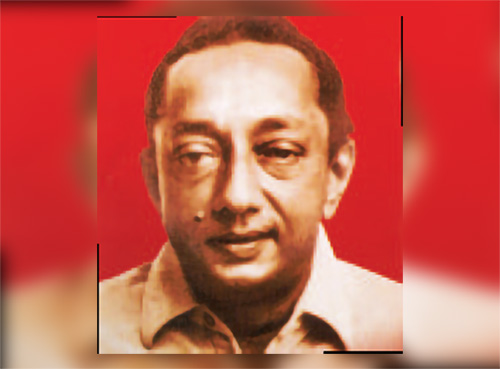
By Lynn Ockersz
There’s this ‘narrative’,
In the ‘Isle of Smug Smiles’,
That the time’s ripe,
To craft the epitaph,
Of the political opposition,
Now that the restive House,
By the idyllic waterway,
Is in the grip of a single party,
In all too familiar history,
But there’s a glowing example,
From the distant eighties,
When Sarath Muththetuwegama,
Lone Member of the CPSL,
Won the admiration of the country,
Through his inspiring speeches,
Clinching the timeless point,
That Quality is superior to Quantity.
-
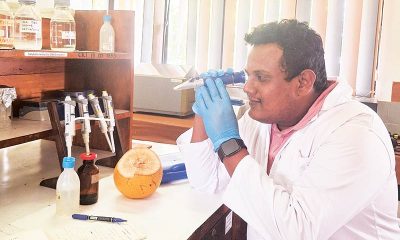
 Life style5 days ago
Life style5 days agoKing of coconuts heads for a golden future
-

 Latest News7 days ago
Latest News7 days agoColombo district preferential votes announced
-
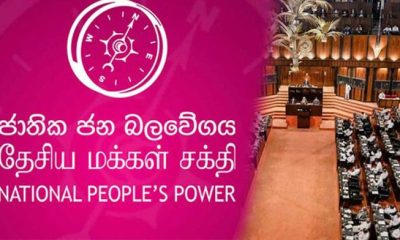
 News4 days ago
News4 days agoNPP appoints two defeated candidates as NL MPs
-
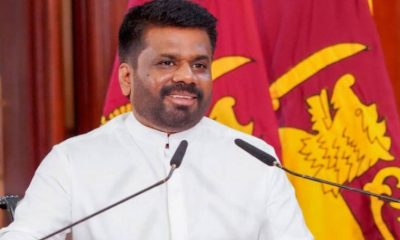
 News6 days ago
News6 days agoPresident warns his party: “We will fail if we view power as an entitlement to do as we please”
-
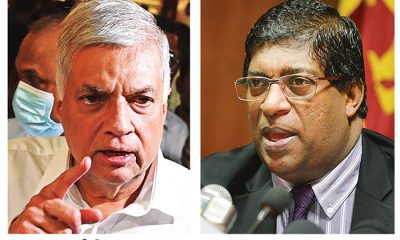
 News3 days ago
News3 days ago‘Gas Cylinder’ explodes; Ranil flays NDF Secy. for submitting Ravi’s name
-
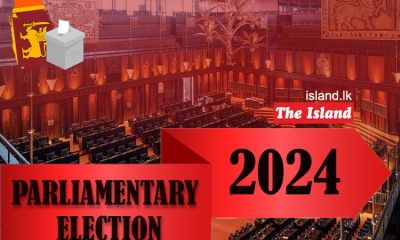
 Latest News7 days ago
Latest News7 days agoGampaha district: NPP 16, SJB 3
-

 Midweek Review2 days ago
Midweek Review2 days ago‘Ramayanizing’ Sri Lanka by Courtesy of SriLankan Airlines
-
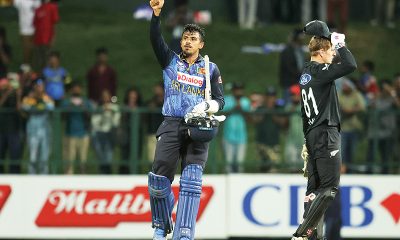
 Sports3 days ago
Sports3 days agoMaking batting compulsory for bowlers has worked – Theekshana











